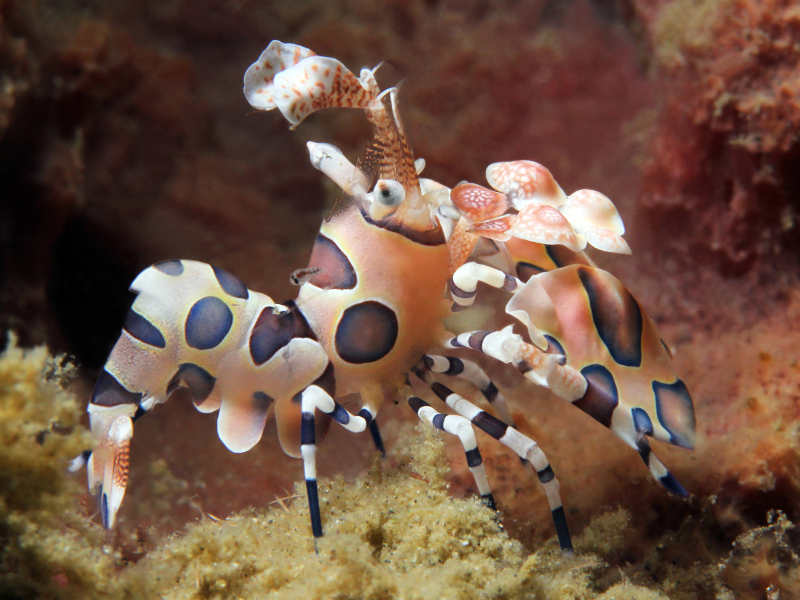Hymenocera picta
Harlequin Shrimp

Scientific Classification
Quick Stats
Aquarium Building Information
About This Species
Basic Description
Detailed Description
The Harlequin Shrimp is an invertebrate for the dedicated marine aquarist, offering a fascinating display of behavior in exchange for very specific husbandry. Hailing from the Indo-Pacific, these crustaceans inhabit coral reefs, a setting that must be replicated in the home aquarium with stable, warm tropical water, medium flow, and alkaline conditions. A mature system is paramount, as they are intolerant of poor water quality. The cornerstone of successful Harlequin Shrimp care is maintaining them as a mated pair. They are socially monogamous and will show signs of stress if kept singly. A bonded pair will often be seen together, sharing food and territory within the aquarium. They are bottom-dwellers that require ample live rock with caves and overhangs for security and exploration.
While they are peaceful towards most reef fish, they can be territorial and aggressive towards other crustaceans, especially other shrimp, and should not be housed with them. The single greatest challenge is their diet. As obligate predators of starfish, they will not accept any alternative foods. Aquarists must provide live starfish on a regular basis. Many keepers establish a separate culture of feeder starfish, or purchase them, to ensure a constant supply. The shrimp will work together to immobilize a starfish, flip it over, and consume it slowly over several days to a week. This unique feeding behavior is captivating but underscores the commitment required. Due to their slow metabolism and infrequent feeding schedule, they contribute minimally to the aquarium's bioload, but the decaying prey can impact water quality if not managed. Their striking appearance makes them a desirable showpiece, but their survival depends entirely on the aquarist's ability to meet their demanding dietary and social needs.
Scientific Description
Hymenocera picta, a decapod crustacean belonging to the Hymenoceridae family, is a highly specialized marine predator. Its morphology is uniquely adapted to its ecological role as an obligate feeder on asteroids (starfish). The body is laterally compressed (compressiform), and it possesses large, ornate, flattened chelipeds (claws) which, despite their size, are not used for crushing but for gripping and manipulating their prey. Sensory perception is acute, utilizing prominent antennules to detect chemical cues released by echinoderms in the water column. This allows them to effectively track their slow-moving prey across the reef substrate.
In its natural Indo-Pacific reef habitat, H. picta plays a role in controlling starfish populations, including the formidable crown-of-thorns starfish, although they typically prey on smaller species like those from the genera Linkia or Asterina. The predation strategy is methodical; the shrimp uses its chelipeds and walking legs to overturn the starfish, rendering its primary defense and locomotion system (tube feet) vulnerable. The shrimp then consumes the tube feet and soft tissues, often starting at the tip of an arm and working its way inward. This process can be slow, with the shrimp keeping their prey alive for an extended period, effectively storing it as a live food source. This behavior is a key survival adaptation for a low-metabolism organism with an infrequent feeding pattern. Socially, the species exhibits monogamy, forming long-term pair bonds that are essential for cooperative hunting and reproduction. Currently, its conservation status has not been evaluated by the IUCN.
Breeding Description
Breeding the Harlequin Shrimp in captivity is considered an exceptionally difficult endeavor, typically achieved only by professional aquaculturists and the most dedicated experts. The foundational requirement for any breeding attempt is a healthy, well-established, and bonded male-female pair. Sexing individuals can be challenging, but females are generally larger and have more pronounced, colorful pleura (abdominal plates) compared to the smaller, less decorated plates of the male. Spawning is initiated after the female successfully molts, a vulnerable period during which the male guards her. The male will then deposit spermatophores onto the female's underside. She will later release her eggs, passing them through the spermatophores for fertilization and then holding the bright clutch under her abdomen until they hatch.
The primary challenge lies not in the spawning, but in raising the larvae. Upon hatching, the shrimp release a large number of pelagic larvae that enter a prolonged planktonic stage. These larvae are tiny, delicate, and require pristine water conditions within a specialized larval rearing system, such as a kreisel tank, which keeps them suspended in the water column without causing physical damage. Feeding the larvae is the next significant hurdle. They must be provided with a continuous supply of specific-sized live micro-foods, starting with certain species of phytoplankton and progressing to newly hatched zooplankton as they develop through numerous molts and zoeal stages. The slightest decline in water quality or a disruption in the food supply will result in a complete loss of the brood. The high mortality rate during this larval phase is what makes successfully raising Harlequin Shrimp to their post-larval stage a remarkable achievement.
Generate Printable Card
Create a printable card for this creature to display in your store or aquarium. The card includes a QR code for quick access to more information.